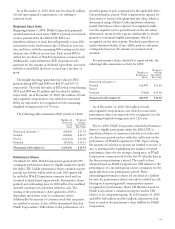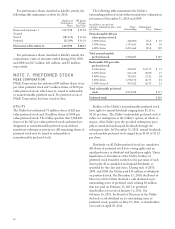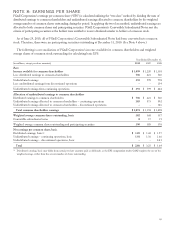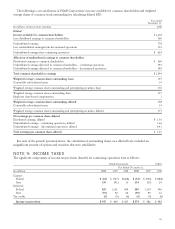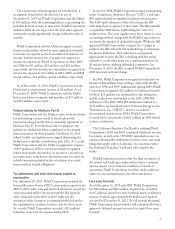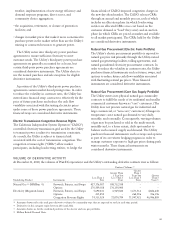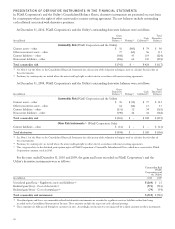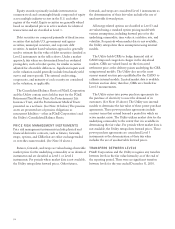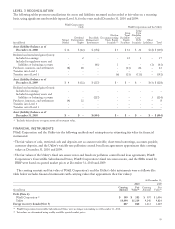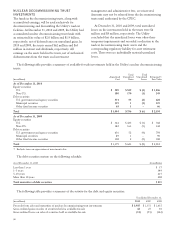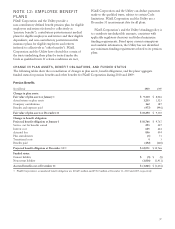PG&E 2010 Annual Report Download - page 93
Download and view the complete annual report
Please find page 93 of the 2010 PG&E annual report below. You can navigate through the pages in the report by either clicking on the pages listed below, or by using the keyword search tool below to find specific information within the annual report.
weather, implementation of new energy efficiency and
demand response programs, direct access, and
community choice aggregation;
• the acquisition, retirement, or closure of generation
facilities; and
• changes in market prices that make it more economical to
purchase power in the market rather than use the Utility’s
existing or contracted resources to generate power.
The Utility enters into third-party power purchase
agreements to ensure sufficient electricity to meet
customer needs. The Utility’s third-party power purchase
agreements are generally accounted for as leases, but
certain third-party power purchase agreements are
considered derivative instruments. The Utility elects to
use the normal purchase and sale exception for eligible
derivative instruments.
A portion of the Utility’s third-party power purchase
agreements contain market-based pricing terms. In order
to reduce the volatility in customer rates, the Utility has
entered into financial swap contracts to effectively fix the
price of future purchases and reduce the cash flow
variability associated with fluctuating electricity prices
under some of those power purchase agreements. These
financial swaps are considered derivative instruments.
Electric TransmissionCongestionRevenue Rights
The California Independent System Operator (“CAISO”)
controlled electricity transmission grid used by the Utility
to transmit power is subject to transmission constraints.
As a result, the Utility is subject to financial risk
associated with the cost of transmission congestion. The
congestion revenue rights (“CRRs”) allow market
participants, including load-serving entities, to hedge the
financial risk of CAISO-imposed congestion charges in
the new day-ahead market. The CAISO releases CRRs
through an annual and monthly process, each of which
includes an allocation phase (in which load-serving
entities are allocated CRRs at no cost based on the
customer demand or “load” they serve) and an auction
phase (in which CRRs are priced at market and available
to all market participants). The CRRs held by the Utility
are considered derivative instruments.
Natural Gas Procurement (Electric Fuels Portfolio)
The Utility’s electric procurement portfolio is exposed to
natural gas price risk primarily through the Utility-owned
natural gas generating facilities, tolling agreements, and
natural gas-indexed electricity procurement contracts. In
order to reduce the volatility in customer rates, the Utility
purchases financial instruments such as futures, swaps, and
options to reduce future cash flow variability associated
with fluctuating natural gas prices. These financial
instruments are considered derivative instruments.
Natural Gas Procurement (Core Gas Supply Portfolio)
The Utility enters into physical natural gas commodity
contracts to fulfill the needs of its residential and smaller
commercial customers known as “core” customers. (The
Utility does not procure natural gas for industrial and
large commercial, or “non-core,” customers.) Changes in
temperature cause natural gas demand to vary daily,
monthly, and seasonally. Consequently, varying volumes
of gas may be purchased or sold in the multi-month,
monthly and, to a lesser extent, daily spot market to
balance such seasonal supply and demand. The Utility
purchases financial instruments such as swaps and options
as part of its core winter hedging program in order to
manage customer exposure to high gas prices during peak
winter months. These financial instruments are
considered derivative instruments.
VOLUME OF DERIVATIVE ACTIVITY
At December 31, 2010, the volumes of PG&E Corporation’s and the Utility’s outstanding derivative contracts were as follows:
Contract Volume (1)
Underlying Product Instruments Less Than 1
Year
Greater Than
1 Year but
Less Than 3
Years
Greater
Than 3
Years but
Less Than 5
Years
Greater
Than 5
Years (2)
Natural Gas (3) (MMBtus (4)) Forwards, Futures, and Swaps 427,176,587 308,712,558 – –
Options 270,509,308 176,150,000 – –
Electricity (Megawatt-hours) Forwards, Futures, and Swaps 5,690,441 6,969,024 3,673,512 4,826,640
Options 415,450 – 264,096 396,396
Congestion Revenue Rights 74,313,524 72,070,789 71,997,921 96,986,809
(1) Amounts shown reflect the total gross derivative volumes by commodity type that are expected to settle in each time period.
(2) Derivatives in this category expire between 2016 and 2022.
(3) Amounts shown are for the combined positions of the electric and core gas portfolios.
(4) Million British Thermal Units.
89




